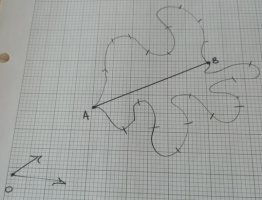Nine Divines
New member
- Joined
- Nov 29, 2020
- Messages
- 12
I have two points, A and B in space. Theorem says only one vector is unique to a sum. But on paper, I can prove this wrong
First let us understand what you mean. You have two points in space [imath]A[/imath] and [imath]B[/imath]. Do you mean that the first vector is from the origin to the point [imath]A[/imath] and the second vector is from the point [imath]A[/imath] to [imath]B[/imath]? Do you mean by vector sum is the sum of these two vectors?I have two points, A and B in space. Theorem says only one vector is unique to a sum. But on paper, I can prove this wrong
So why not show us your proof so that we can confirm that you are correct or point out an error in your proof????I have two points, A and B in space. Theorem says only one vector is unique to a sum. But on paper, I can prove this wrong
Please state the theorem as found in your source. What you have said is not clear.I have two points, A and B in space. Theorem says only one vector is unique to a sum. But on paper, I can prove this wrong
Again, please state the theorem you are claiming to be wrong, as clearly as possible. Ideally, I want to see a proper source, so we can see it in context.It's not a proof, just a diagram of my thought. I can get from A to B in more than one way. If I break up the curves into line elements, this shows the sum is non unique

You have just showed the theorem is correct. No matter how you go from point [imath]A[/imath] to point [imath]B[/imath], the vector sum has a unique solution depends only on the starting point [imath]A[/imath] and ending point [imath]B[/imath].It's not a proof, just a diagram of my thought. I can get from A to B in more than one way. If I break up the curves into line elements, this shows the sum is non unique
He meant the sum of the two vectors below the picture. He just shifted this sum to the middle of the picture for illustration.Again, please state the theorem you are claiming to be wrong, as clearly as possible. Ideally, I want to see a proper source, so we can see it in context.
View attachment 38203
Your picture shows only one vector AB, not a sum; curved lines have nothing to do with vectors.
There is a theorem that a straight line is the shortest path from A to B (so that your two curves are longer than the segment, but that is not about vectors.
I know of no claim that there is only one set of vectors whose sum is a given vector; that's obviously false. So, again, you must be misinterpreting something you've read, and we can't help you correct that until you show us what you have seen.
